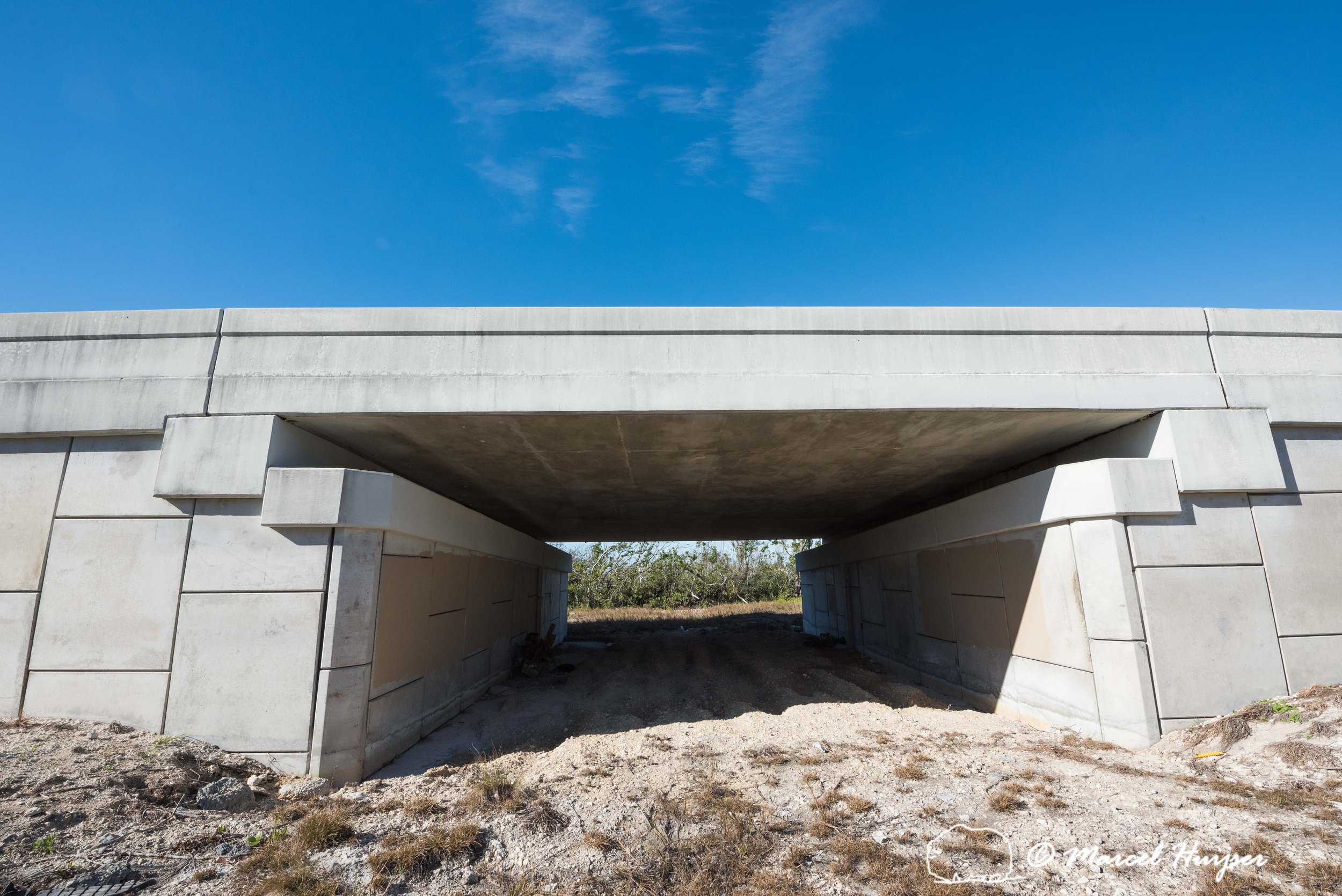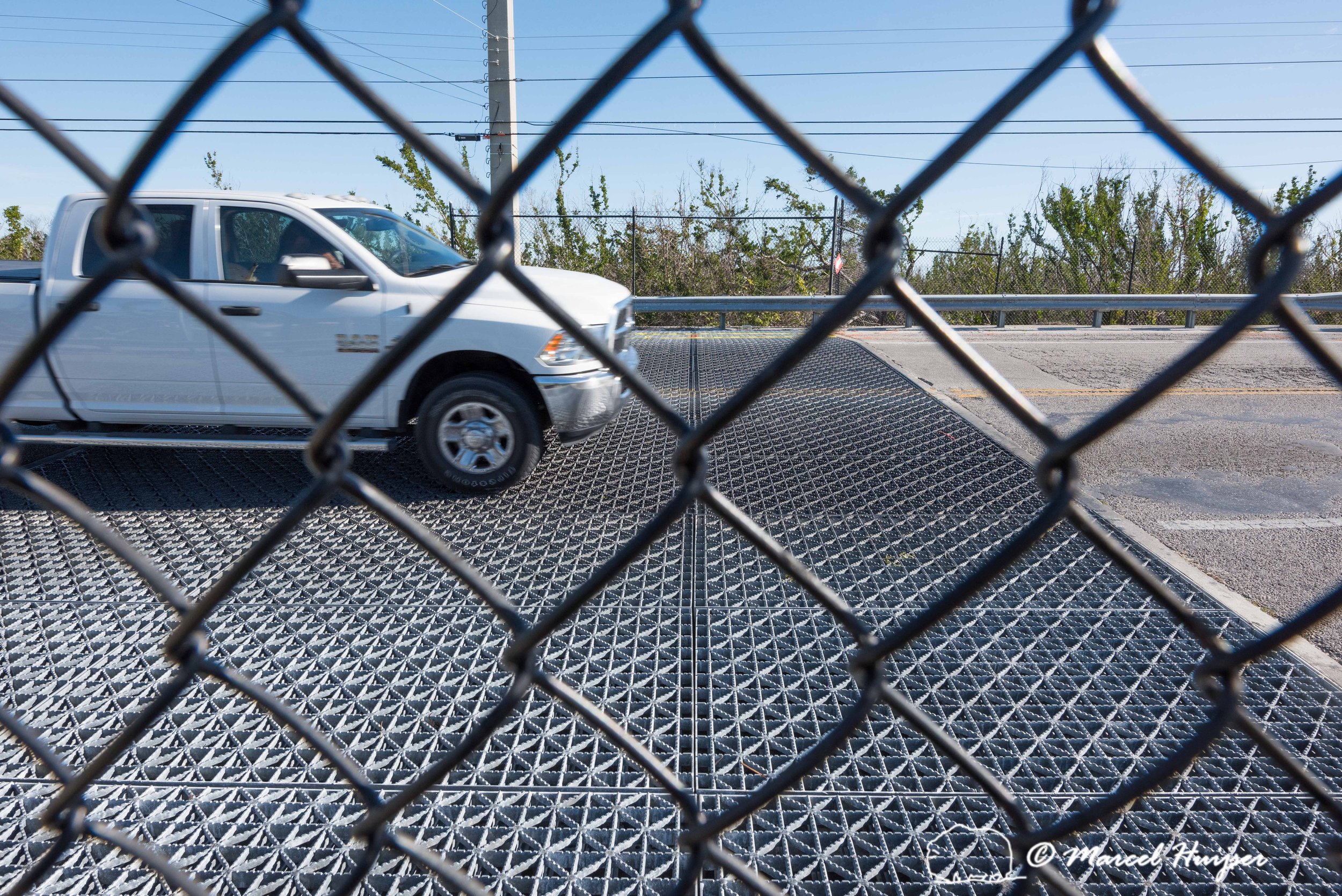Don’t fall short on fencing!
Written By Marcel P. Huijser
Western Transportation Institute, Montana State University
5th August 2022
The mitigation measures
Florida Key deer are an endangered subspecies of white-tailed deer that live on islands to the southwest tip of Florida, USA. These islands are referred as “the Florida Keys” and many of the islands have the word “key” in their name. Mortality data (collected between 1966–2017) on all roads in the area showed that about 75% of all reported deer mortalities were related to collisions with vehicles. An estimated 85% of the Key deer occur on Big Pine Key and No Name Key. In 2001–2002, the eastern 1.64 mi (2.64 km) long section of US Hwy 1 on Big Pine Key was mitigated with a wildlife fence, 2 underpasses, and 4 “deer guards” (i.e. similar to cattle guards).
Figure 1. The mitigated section of US Hwy 1 on Big Pine Key.
Figure 2, 3 & 4. The wildlife fence, one of the underpasses and the “deer guards” on Big Pine Key
No net benefit of the mitigation measures in reducing road mortality
After mitigation, the number of reported Key deer road mortalities reduced substantially in the mitigated section, but this was negated by an increase in collisions along the unmitigated section of US Hwy 1 on Big Pine Key, both in absolute numbers and expressed as a percentage of the total deer population size. The data also showed that the increase in Key deer collisions along the unmitigated highway section on the island could not be explained through an increase in Key deer population size, or by a potential increase in traffic volume. The overall Key deer road mortality along US Hwy 1 was not reduced but was moved from the mitigated section to the nearby unmitigated section, despite others having documented use of the 2 underpasses by Key deer. Thus, there was no net benefit of the fence and associated measures in reducing collisions. In addition, this meant that the unmitigated section of Hwy 1 on Big Pine Key was not suited as a control for an analysis of the effectiveness of the mitigation measures in reducing collisions along the mitigated road section. However, the road sections of Hwy 1 off Big Pine Key were unaffected by the mitigation measures and were a suitable control for a Before-After-Control-Impact (BACI) analysis
Figure 5. The number of Key deer road mortalities per year along all roads on all the islands combined (1966–2016) and during the ten years before (1991–2000) and the fourteen years after mitigation (2003–2016) along both the mitigated and unmitigated section of US Hwy 1 on Big Pine Key (BPK).
Figure 6. The average percentage (and SD) of roadkilled Key deer of the total estimated population size in the years before and after implementation of the mitigation measures along the eastern section of US Hwy 1 on Big Pine Key (BPK).
Fence-end effect and moving the problem further away along unmitigated road section
After mitigation, a significant hotspot of Key deer-vehicle collisions appeared at the western fence-end, and additional hotspots occurred further west along the unmitigated highway. This was further evidence that the unmitigated section of Hwy 1 on Big Pine Key was not suited as a control for a BACI analysis into the effectiveness of the mitigation measures in reducing deer-vehicle collisions.
Figure 7. Significant hotspots (red shading) and cold spots (grey shading) for Key deer-vehicle collisions along US Hwy 1 before (a) and after (b) mitigation. Numbers represent the mile reference posts.
The mitigation measures did reduce collisions along fenced road section
We selected highway sections west and east of Big Pine Key, off the island, as a control. These road sections included sections of Hwy 1 that were on other islands as well as on bridges and embankments between the islands. The BACI analysis showed that the wildlife fence and associated mitigation measures were highly effective (95%) in reducing deer-vehicle collisions along the mitigated highway section. Nonetheless, to reduce the overall number of deer-vehicle collisions along US Hwy 1, the entire highway section on Big Pine Key would need to be mitigated. However, further mitigation is complicated because of the many buildings and access roads for businesses and residences; a fence would hinder access to residential areas as well as businesses along the highway.
Figure 8. The average number (and SD) of Key deer-vehicle collisions per mile per year in the control and mitigated road section before and after the mitigation measures were implemented.
Fences reduce collisions, but don’t fall short!
This case study illustrates that while fences and associated measures can be very effective in reducing collisions, wildlife fences that are too short may result in an increase in collisions in nearby unmitigated road sections, especially near fence-ends. Therefore, it is important to carefully consider the appropriate spatial scale over which highway mitigation measures are implemented and evaluated
Author information:
Marcel P. Huijser (mhuijser@montana.edu), Western Transportation Institute, Montana State University, PO Box 174250, Bozeman, MT 59717-4250, USA
Source:
Huijser MP, Begley JS (2022) Implementing wildlife fences along highways at the appropriate spatial scale: A case study of reducing road mortality of Florida Key deer. In: Santos S, Grilo C, Shilling F, Bhardwaj M, Papp CR (Eds) Linear Infrastructure Networks with Ecological Solutions. Nature Conservation 47: 283–302. https://doi.org/10.3897/natureconservation.47.72321
Editor:
Rodney van der Ree
Cite this summary:
Huijser MP. (2022). Don’t fall short on fencing! Edited by van der Ree, R. TransportEcology.info, Accessed at: https://transportecology.info/research/wildlife-fencing-mitigation-measures [Date accessed].









